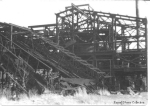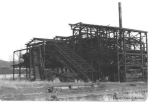





Mile Mark: 0.60
Elevation: 585'
Date Built: 1915
Published Photos: EBT 108, 128, 149, 166, 167, 236; AEBT 24, 88, 92
A wooden trestle built in 1873 was used to transfer coal from narrow gauge cars on top to standard gauge cars below. There was no sorting or cleaning involved. About 1910 the trestle was rebuilt and doubled in size. The trestle was later demolished in favor of this new sorting plant.
The apron conveyer plant was constructed in 1915. The new arrangement necessitated a longer yard to accommodate switching through the plant, and most of the yard north of the plant was constructed at that time including the new main over Hill Valley Creek. The 1872 main was replaced with a new one passing over the current concrete culvert and closer to the Juniata River than the original. A mazework of narrow, dual and standard gauge track allowed all the loading bays to be serviced by both gauges of cars. The unloading area had one narrow and one dual gauge track.
In the unloading area the cars were spotted in a shed covereing a pit. Coal was dumped into the pit and brought up into the plant on one of two conveyers. Inside the plant the coal passed over a number of vibrating screens which separated the coal into a variety of sizes, such as stoker, range, furnace and lump, or it could be left unsorted, or run-o'-mine. Sorting the coal into different grades made it more marketable. In the final configuration there were seven loading tracks. A mazework of track and switches as well as the EBT's only diamond crossover allowed cars of either gauge to reach any of the seven tracks, albeit not always via a direct route.
In the original plant arrangement, twenty six men picked out debris as the coal was sorted. As coal production increased, a more efficient method was needed. In the summer of 1925 the plant was upgraded to include a Chance Coal Cleaner. This was the first Chance Coal Cleaner constructed for use in a bituminous coal field. Used for many years before in the Anthracite coal industry, in the Chance process water and sand (actually a ground pumice) are mixed in specific proportions such that coal will float on the mixture, but stone will sink. In this way the rock and junk coal with rock impurities, or "boney", could be removed before sorting. Several hopper and air dump cars were assigned to the duty of hauling boney away from the plant and dumping it on large long piles at the south end of the yard. There was a separate loading area for the boney cars at the south end of the plant between the loading and unloading tracks. Coal cleaning and sorting was an option, and not all coal was so processed. Coal for home heating use was usually just transloaded to standard gauge cars.
To the north of the main plant were two storehouses for the plant. One was 20'x40' of brick (probably a block construction) with a corrugated steel roof. Maps and photos indicate it appears to have had 10' frame extensions out from the long side making its real size about 40'x40'. The storehouse further north was about 20'x60' and was probably steel frame construction with corrugated steel sheathing. It was unusual in that it was painted a light grey or silver color instead of black like the rest of the plant. South of the plant were two additional outbuildings. The northern, immediately by the boney loading area was 'sample house', probably for testing samples of processed coal. Like the northmost storehouse, this building was also a light color and may have had block walls. The one a short distance south of the plant was the 'pump house'. It doubtless provided water to the plant and may have also provided water purification necessary for the precise Chance process. It appears to have been frame with corrugated siding. Immediatly south of the pump house was an open pit 'settling tank'.
After the close of operations the plant stood derelict and vandalized until an abortive effort to scrap it in the early 70's left it without its sheathing. In 1979 the plant, associated buildings and most of the track under it was scrapped. Today the concrete footings, unloader and sand floatation collection cone are all that remain. The cone still contains sand from the Chance process. A standard gauge tank car hooked up to the plant still remains on a storage track next to the boney loading track. It once contained oil that, for an extra charge, could be sprayed on the inside of hoppers in the winter to ease unloading problems from frozen coal. A standard EBT steel boxcar accompanies the tank car, and may have housed sand or water treatment chemicals. Parts of the pump house facility still stand. Of the two storehouses, only the foundations remain.

Back to Mount Union North Dual Gauge Yard |
Click on an image to see larger version
|
Forward to Mount Union Coal Trestle |
||
|---|---|---|---|---|
| Up to Mount Union Yards | ||||
| Up to EBT: Mount Union to Shirleysburg | ||||
| Tour Entry | Tour Index | Tour Info | ||